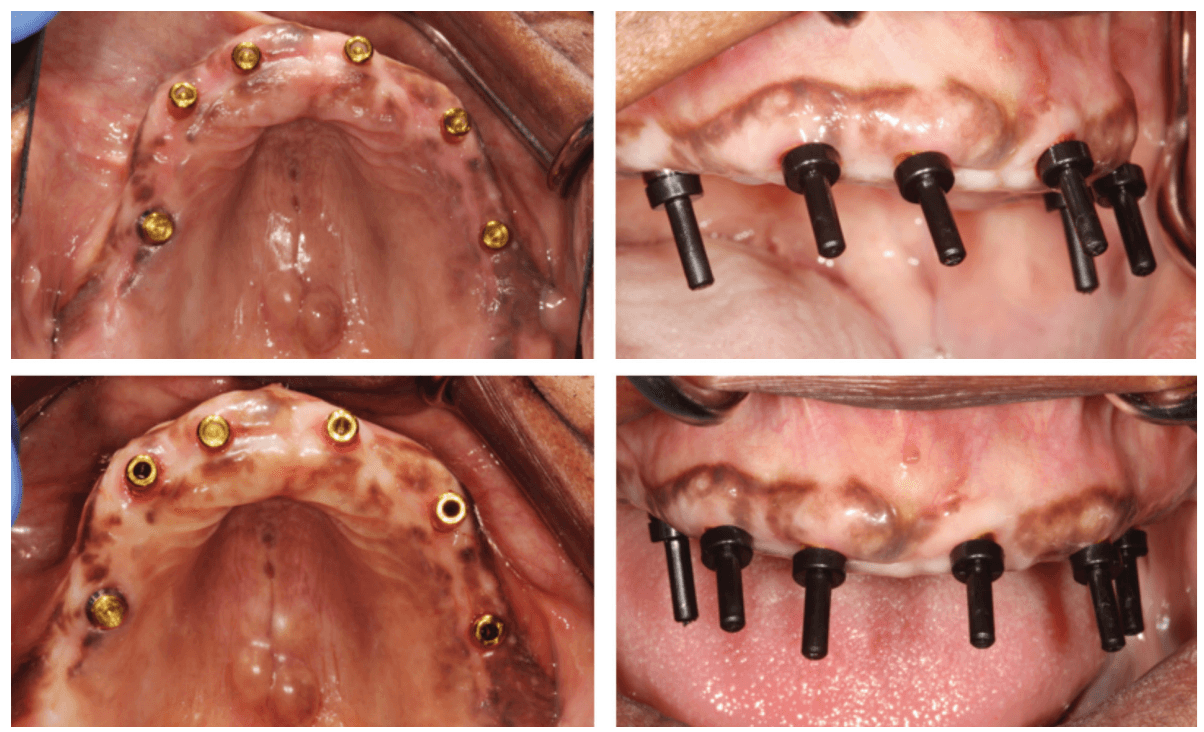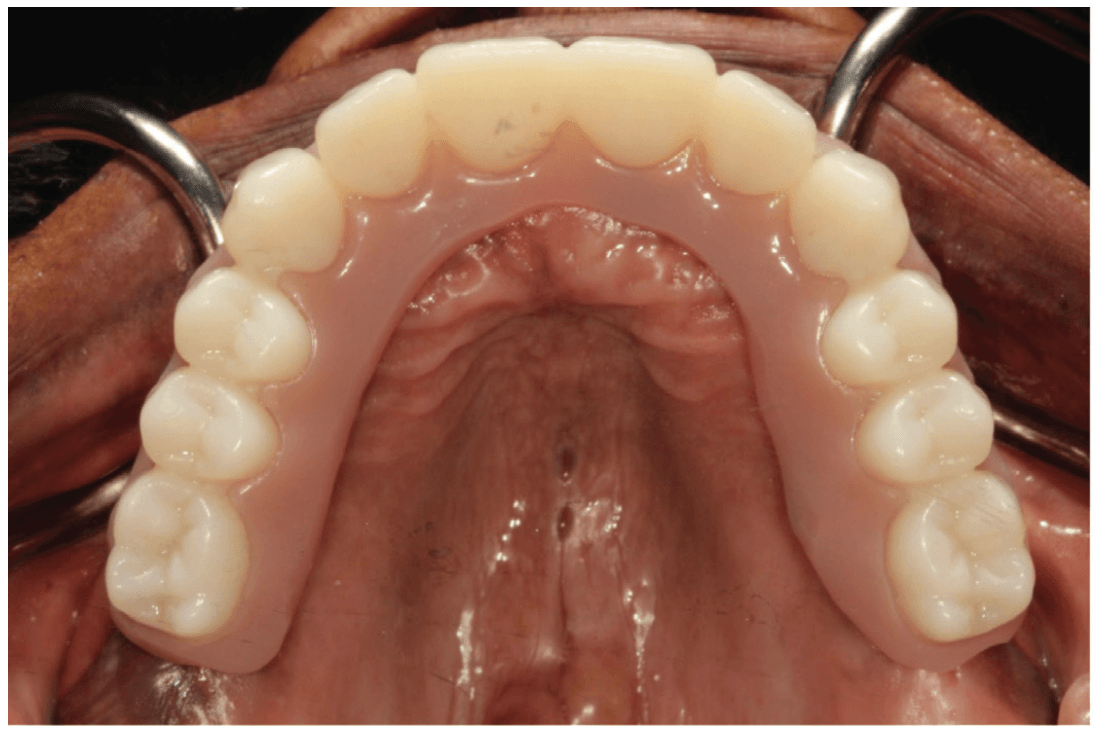In our Cover Story, Dr. Sundeep Rawal; Eric Kukucka, DD; and Dr. Nassif Youssef illustrate how to overcome suboptimal implant positioning by using Locator Angled abutments.

Dr. Sundeep Rawal; Eric Kukucka, DD; and Dr. Nassif Youssef discuss experience with angled implants for full-arch cases and how LOCATOR Angled fits into their clinical practices
The evolution of implant dentistry continuously seeks to address the complexities clinicians face in achieving optimal prosthetic outcomes. One persistent challenge has been the management of non-ideal implant angulations, which can compromise the functional and esthetic results of both removable and fixed prosthetic designs.
In removable prosthetic cases, the success of overdentures heavily depends on the alignment and distribution of the supporting implants. Suboptimal implant positioning, whether due to anatomical limitations or surgical inconsistencies, can create functional and esthetic issues for the patient. Traditional Locator® abutments, while effective, are sometimes insufficient to overcome angulation challenges, particularly in cases exceeding 10 – 15 degrees of divergence. With Locator abutments, the housing compensates for the malposition of implants, allowing a maximum divergence of 20 degrees total with standard housings and up to 40 degrees total with extended range inserts. In a typical 4-implant overdenture case, this equates to either only 5 or 10 degrees of correction per implant, often falling short in managing significant angulation issues.

Locator Angled abutments present a transformative solution to this challenge when utilizing individual stud-type connections of prosthetics to implants, offering clinicians enhanced flexibility and predictability in their cases. The pre-angled Locator Angled abutment corrects 15 degrees of angulation and allows for the clinician to restore implants up to 35 degrees of angulation.
Clinically, this innovation eliminates the need for invasive corrective surgeries or additional components to accommodate for angulation discrepancies, which can lead to a reduction in the prosthetic restorative space due to the height of additional components needed to compensate. For instance, in a recent case involving a mandibular overdenture, the use of Locator Angled abutments allowed seamless adaptation to significant divergence between anterior and posterior implants. The result was a prosthesis with superior retention, stability, and patient satisfaction without compromising the gingival esthetics or the longevity of the attachment system. Moreover, the Locator Angled system simplifies chairside adjustments, reducing the need for extensive prosthetic modifications or complex restorative solutions that could increase treatment time and cost. By providing a predictable seating path and robust retention, these abutments ensure a streamlined workflow and fewer prosthetic and post-delivery complications. For the patient, this translates to improved comfort and confidence in their removable prosthetic solution.

While traditionally associated with removable prosthetics, Locator Angled abutments have demonstrated equal impact in the realm of fixed implant-supported prostheses. Fixed full-arch restorations often face angulation challenges due to implant placement dictated by anatomical constraints or previous restorative work. In these scenarios, Locator Angled abutments provide a solution that combines the precision of fixed restorations with the adaptability of angled correction.
Consider a clinical case of a maxillary full-arch restoration where implants (Straumann® BLX) were placed with significant buccal angulation due to the constraints of the patient’s anatomy. Traditional abutments would have necessitated excessive prosthetic bulk or compromised the anterior posterior spread (A-P Spread) of the restoration. Utilizing Locator Angled abutments, the divergence was corrected efficiently, ensuring proper prosthetic alignment, and reducing stress on the framework while ensuring maximum A-P spread. The ability to adjust angulation without complex laboratory workflows also supports cost-effective treatment solutions.

By mitigating the need for custom abutments or extensive laboratory work, Locator Angled abutments enable clinicians to deliver high-quality fixed solutions with enhanced efficiency. Additionally, their compatibility with modern digital workflows ensures seamless integration into both analog and digital treatment paradigms.
These clinical cases demonstrate that the Locator Angled abutment addresses one of the most critical problems in implant dentistry: the reconciliation of “less-than-ideal” implant positions with the need for predictable and durable prosthetic outcomes. Whether used in removable or fixed applications, these abutments simplify complex cases, reduce the need for surgical or prosthetic compromises, and enhance patient satisfaction. However, another benefit of this innovation is the ability to enable a comprehensive treatment plan that spans the entire “life cycle of care” for patients.

Historically, the formulation of a patient’s treatment plan and subsequent planned implant positioning was dictated by the proposed definitive restoration being either fixed or removable. If the patient was planned for a removable prosthesis with individual stud-type attachments without the use of a CAD/CAM milled framework, then parallelism of implant placement was paramount, even at the expense of the Anterior-Posterior distribution of implants. This planned positioning was much different than when planning for a fixed solution where tilting of implants to diverge them and increase the A-P spread has become the prevailing technique over the past two decades for achieving optimal implant positioning.
Unfortunately, these two approaches to implant placement are not synergistic, and in most cases, planning one modality of placement precluded the ability to deliver the other type of restoration at a future date. If parallel implants were placed for removable therapies, the distribution was less than ideal for a fixed, fully implant-supported restoration in the future. If that transition was desired, further surgical intervention was needed to place more implants with or without adjunctive procedures such as bone augmentation. This was a similar situation if implants were tilted for maximum spread in preparation of a fully implant-supported restoration. In those cases, the use of stud-type attachments like the Locator abutment system were precluded due to divergence unless a CAD/CAM milled framework was utilized as well to splint the implants together and create the ability for the attachment system to have parallelism for a path of insertion. Unfortunately, these methods of treatment are costly, laborious, and hinder optimal prosthetic outcomes.
The Locator Angled abutment system allows clinicians to overcome this dichotomy in treatment planning. Today, a patient can be treatment planned to maximize the distribution of implants with a fully implant-supported restoration in mind, tilting implants to accomplish this while simultaneously avoiding critical anatomical structures and circumventing the need for complex grafting procedures. With the use of Locator Angled abutments, the initial definitive restoration can be a removable prosthesis with individual stud-type locator abutments and attachments, which can transition to a fixed, fully implant-supported restoration later. Along with the advent of the Locator Fixed concept in conjunction with the innovation of the Locator Angled abutment, a uniform methodology can be applied to the treatment planning of full-arch implant solutions with four or more implants allowing versatility in how a patient can progress through a life cycle of therapy without necessitating further surgical intervention.
In summary, Locator Angled abutments empower clinicians to overcome angulation challenges with precision and ease. Their versatile application and synergistic convergence in implant placement planning for both removable and fixed prosthetics highlight their crucial role in modern implant dentistry by enabling a standardized, cohesive methodology. This unified approach offers exceptional versatility in how patients progress through the treatment progress, eliminating the need for additional surgeries or interventions at later stages.
Besides the Locator Angled abutments, Zest Dental Solutions offers other full-arch implant solutions. Read Dr. Michael Scherer’s tips for doing more LOCATOR FIXED™ full-arch implantology cases: https://implantpracticeus.com/focusing-on-fixed-full-arch/
- Amato F, Polara G. Clinical Application of the New LOCATOR F-Tx Fixed Attachment System for Immediate Rehabilitation of Complete Edentulous Cases: 1-Year Prospective Clinical Study. Compend Contin Educ Dent. 2018;39(1). https://www.compendiumlive.com/2018/zest-supplement/clinical-application-of-the-new-locator-f-tx-fixed-attachment-system-for-immediate-rehabilitation-of-complete-edentulous-cases-1-year-prospective-clinical-study/. Accessed January 30, 2025.
- Al-Shehri AN. Overdenture Treatment of Angled Implant with Extended Range Locator Attachment: Clinical Report. J Am Sci. 2020;16(2):9-15.
- Alqutaibi AY, Kaddah AF. Effect of Mastication Load on Retention Force of Custom-Made LOCATOR Attachments for Implant Overdentures. J Prosthet Dent. 2023;129(4):680.e1-680.e7.
- Alikhasi M, Siadat H, Hashemloo A, Bassir SH. CAD-CAM Fabrication of Semiprecision LOCATOR-Style Abutments to Correct Implant Angulation. J Prosthet Dent. 2024;131(2):181-184.
Stay Relevant With Implant Practice US
Join our email list for CE courses and webinars, articles and mores



